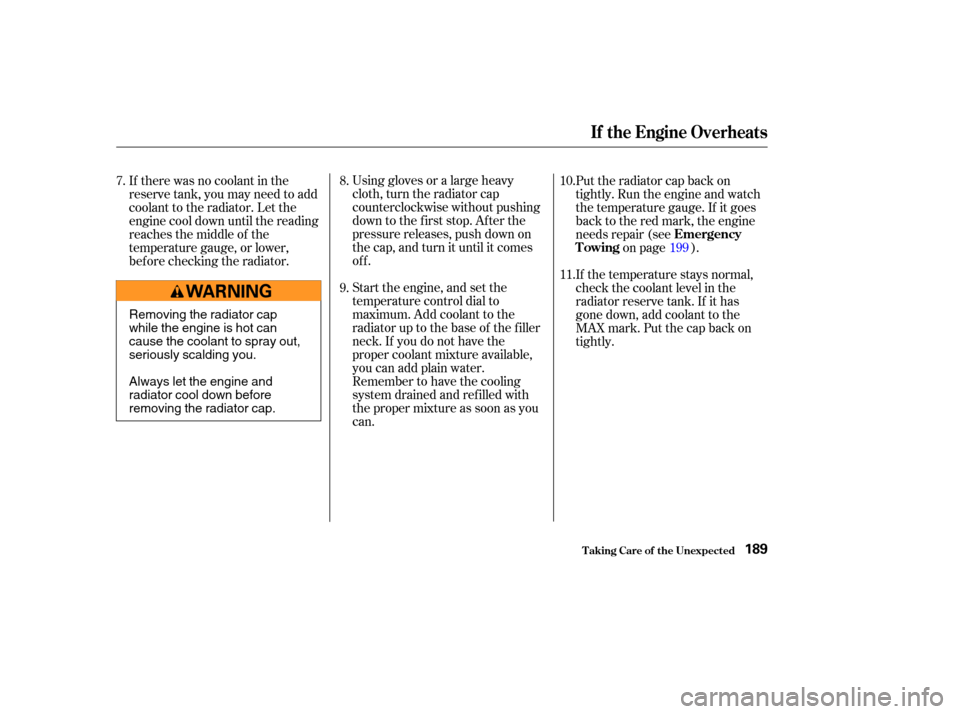Page 130 of 231
This section gives you tips on
starting the engine under various
conditions, and how to operate the
5-speed manual and automatic
transmissions. It also includes impor-
tant inf ormation on parking your
vehicle, and the braking system.........................
Preparing to Drive .128
.......................
Starting the Engine .129
....
5-speed Manual Transmission . 130
.
Automatic Transmission (CVT) . 133
...........................................
Parking .139
.............................
Braking System .140
...............
Anti-lock Brakes (ABS) . 141
...........................
Towing a Trailer .142
Driving
Driving127
Page 145 of 231
Your vehicle is not designed to tow a
trailer. Attempting to do so can void
your warranties.
Towing a Trailer
Driving142
Page 180 of 231
This section covers the more
common problems that motorists
experience with their vehicles. It
gives you inf ormation about how to
safely evaluate the problem and what
to do to correct it. If the problem has
stranded you on the side of the road,
you may be able to get going again.
If not, you will also f ind instructions
on getting your vehicle towed.......................
Compact Spare Tire .178
....................
Changing a Flat Tire .179
.............
If the Engine Won’t Start . 184
................................
Jump Starting .186
..............
If the Engine Overheats . 187
.........
Low Oil Pressure Indicator . 190
..........
Charging System Indicator . 191
.......
Malf unction Indicator Lamp . 192
...............
Brake System Indicator . 193
..............................................
Fuses .194
..............................
Fuse Locations .197
......................
Emergency Towing .199
Taking Care of the Unexpected
T aking Care of t he Unexpect ed177
Page 188 of 231
In this case, the starter motor’s
speed sounds normal, or even f aster
than normal, when you turn the
ignition switch to START (III), but
the engine does not run.Are you using a properly coded
key? An improperly coded key will
cause the immobilizer system
indicator in the instrument panel
to blink rapidly (see page ).
Are you using the proper starting
procedure? Ref er to on page . Do you have f uel? Check the f uel
gauge; the low f uel indicator may
not be working.
There may be an electrical
problem, such as no power to the
f uel pump. Check all the f uses
(see page ).
If youfindnothingwrong,youwill
need a qualif ied technician to f ind
the problem. See
on page .
71
129 199
194
If theEngineWon’tStart
T he Starter Operates Normally
Starting the
Engine Emergency
Towing
T aking Care of t he Unexpect ed185
Page 191 of 231

Saf ely pull to the side of the road.
Put the transmission in Neutral or
Park, and set the parking brake.
Turn of f all the accessories, and
turn on the hazard indicator.
If you see steam and/or spray
coming f rom under the hood, turn
of f the engine. Wait until you see
no more signs of steam or spray,
then open the hood.If you do not see steam or spray,
leave the engine running and
watch the temperature gauge. If
the high heat is due to overloading,
the engine should start to cool
down almost immediately. If it
does, wait until the temperature
gauge comes down to the midpoint,
then continue driving.
If the temperature gauge stays at
the red mark, turn of f the engine.Look f or any obvious coolant leaks,
such as a split radiator hose.
Everything is still extremely hot,
so use caution. If you f ind a leak, it
must be repaired bef ore you
continue driving (see
on page ).
If you don’t f ind an obvious leak,
check the coolant level in the
radiator reserve tank. Add coolant
if the level is below the MIN mark.
1.
2.
3.
4.5.
6.
199
If theEngineOverheats
T aking Care of t he Unexpect ed
Emergency
Towing
188
Page 192 of 231

Using gloves or a large heavy
cloth, turn the radiator cap
counterclockwise without pushing
down to the first stop. After the
pressure releases, push down on
the cap, and turn it until it comes
off.
Start the engine, and set the
temperature control dial to
maximum. Add coolant to the
radiator up to the base of the f iller
neck. If you do not have the
proper coolant mixture available,
you can add plain water.
Remember to have the cooling
system drained and ref illed with
the proper mixture as soon as you
can.Put the radiator cap back on
tightly. Run the engine and watch
the temperature gauge. If it goes
back to the red mark, the engine
needs repair (see
on page ).
If the temperature stays normal,
check the coolant level in the
radiator reserve tank. If it has
gone down, add coolant to the
MAX mark. Put the cap back on
tightly.
If there was no coolant in the
reserve tank, you may need to add
coolant to the radiator. Let the
engine cool down until the reading
reaches the middle of the
temperature gauge, or lower,
bef ore checking the radiator.
8.
9. 10.
11.
7.
199
If theEngineOverheats
T aking Care of t he Unexpect ed
Emergency
Towing
189
Removing the radiator cap
while the engine is hot can
cause the coolant to spray out,
seriously scalding you.
Always let the engine and
radiator cool down before
removing the radiator cap.
Page 196 of 231

The brake system indicator
normally comes on when
you turn the ignition switch
ON (II) and as a reminder
to check the parking brake.
It will stay lit if you do not
f ully release the parking
brake.
If the brake system indicator comes
on while driving, the brake f luid level
is probably low. Press lightly on the
brake pedal to see if it f eels normal.
If it does, check the brake f luid level
thenexttimeyoustopataservice
station (see page ).
If the f luid level is low, take your
vehicle to the dealer and have the
brake system inspected f or leaks or
worn brake pads.
However, if the brake pedal does not
f eel normal, you should take
immediate action. A problem in one
part of the system’s dual circuit design will still give you braking at
two wheels. You will f eel the brake
pedal go down much f arther bef ore
the vehicle begins to slow down and
you will have to press harder on the
pedal.
Slow down by shif ting to a lower
gear, and pull to the side of the road
when it is saf e. Because of the long
distance needed to stop, it is
hazardous to drive the vehicle. You
should have it towed and repaired as
soon as possible (see
on page ).
If you must drive the vehicle a short
distance in this condition, drive
slowly and caref ully. If the ABS indicator comes on with
this indicator, have the vehicle
inspected by your Honda dealer
immediately.
199
160On models equipped with ABS
Brake System Indicator
T aking Care of t he Unexpect ed
Emergency
Towing
193
Canada U.S.
Page 202 of 231

�µ
�µ
The tow
truck uses two pivoting arms that go
under the tires (f ront or rear) and lif t
them of f the ground. The other two
tires remain on the ground. If your vehicle needs to be towed,
call a prof essional towing service or
organization. Never tow your vehicle
with just a rope or chain. It is very
dangerous.
The operator
loads your vehicle on the back of a
truck. With the f ront wheels on the ground,
it is best to tow the car no farther
than 50 miles (80 km), and keep the
speedbelow35mph(55km/h).
If your vehicle is equipped with a
f ront spoiler, remove it bef ore
towing so it is not damaged.
Therearetwowaystotowyour
vehicle.
If , due to damage, your vehicle must
be towed with the f ront wheels on
the ground, do the f ollowing:
Release the parking brake.
Shif t the transmission to Neutral.
Release the parking brake.
Start the engine.
ShifttoD,thentoN.
Turn of f the engine.
5-speed Manual Transmission:
Automatic Transmission (CVT):
Wheel-lif t Equipment
Flat -bed Equipment
T his is
an acceptable way to tow your
Honda. This is the best way to trans-
port your Honda.
Emergency T owing
T aking Care of t he Unexpect ed199
NOTICE:
NOTICE: Improper towing preparation
will damage the transmission. Follow
the above procedure exactly. If you
cannot shif t the transmission or start
the engine (automatic transmission),
your vehicle must be transported with
the f ront wheels of f the ground.
Trying to lif t or tow your
vehicle by the bumpers will cause
serious damage. The bumpers are not
designed to support the vehicle’s weight.